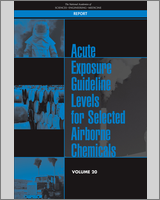NCBI Bookshelf. A service of the National Library of Medicine, National Institutes of Health.
Extremely hazardous substances can be released accidentally as a result of chemical spills, industrial explosions, fires, or accidents involving railroad cars and trucks transporting EHSs. Workers and residents in communities surrounding industrial facilities where these substances are manufactured, used, or stored and in communities along the nation's railways and highways are potentially at risk of being exposed to airborne EHSs during accidental releases or intentional releases by terrorists. Pursuant to the Superfund Amendments and Reauthorization Act of 1986, the U.S. Environmental Protection Agency (EPA) has identified approximately 400 EHSs on the basis of acute lethality data in rodents.
Acute Exposure Guideline Levels for Selected Airborne Chemicals, Volume 20 reviews and updates the technical support document on acute exposure guideline levels (AEGLs) for selected chloroformates. This update focuses on establishing AEGL-3 values for n-propyl chloroformate and isopropyl chloroformate, but will also consider whether any new data are available that would affect the proposed values for the other 10 chloroformates.
AEGLs represent threshold exposure limits (exposure levels below which adverse health effects are not likely to occur) for the general public and are applicable to emergency exposures ranging from 10 minutes (min) to 8 h. Three levels - AEGL-1, AEGL-2, and AEGL-3 - are developed for each of five exposure periods (10 min, 30 min, 1 h, 4 h, and 8 h) and are distinguished by varying degrees of severity of toxic effects. This report will inform planning, response, and prevention in the community, the workplace, transportation, the military, and the remediation of Superfund sites.
Contents
- The National Academies of SCIENCES • ENGINEERING • MEDICINE
- COMMITTEE ON ACUTE EXPOSURE GUIDELINE LEVELS
- COMMITTEE ON TOXICOLOGY
- BOARD ON ENVIRONMENTAL STUDIES AND TOXICOLOGY
- OTHER PUBLICATIONS OF THE BOARD ON ENVIRONMENTAL STUDIES AND TOXICOLOGY
- OTHER PUBLICATIONS OF THE COMMITTEE ON TOXICOLOGY
- Preface
- Summary
- 1. Introduction
- 2. Chloroformates Acute Exposure Guideline Levels
- 1. GENERAL INFORMATION ON SELECTED CHLOROFORMATES
- 2. METHYL CHLOROFORMATE
- 3. ETHYL CHLOROFORMATE
- 4. ISOPROPYL CHLOROFORMATE
- 5. n-PROPYL CHLOROFORMATE
- 6. ALLYL CHLOROFORMATE
- 7. n-BUTYL CHLOROFORMATE, ISOBUTYL CHLOROFORMATE, AND sec-BUTYL CHLOROFLORMATE
- 8. BENZYL CHLOROFORMATE
- 9. PHENYL CHLOROFORMATE
- 10. 2-ETHYLHEXYL CHLOROFORMATE
- 11. ETHYL CHLOROTHIOFORMATE
- REFERENCES
- APPENDIXES
- Appendix A. Biographical Information Committee on Acute Exposure Guidelines for Chloroformates
- Appendix B. Benchmark Concentration Calculations for Selected Chloroformates
- Appendix C. Derivation of AEGL Values for Selected Chloroformates
- Appendix D. Acute Exposure Guideline Levels for Selected Chloroformates
- Appendix E. Category Plots for Selected Chloroformates
Suggested citation:
National Academies of Sciences, Engineering, and Medicine. 2016. Acute Exposure Guideline Levels for Selected Airborne Chemicals: Volume 20. Washington, DC: The National Academies Press. doi: 10.17226/23634.
- Review Acute Exposure Guideline Levels for Selected Airborne Chemicals: Volume 16[ 2014]Review Acute Exposure Guideline Levels for Selected Airborne Chemicals: Volume 16Committee on Acute Exposure Guideline Levels, Committee on Toxicology, Board on Environmental Studies and Toxicology, Division on Earth and Life Studies, National Research Council. 2014 Mar 21
- Review Acute Exposure Guideline Levels for Selected Airborne Chemicals: Volume 14[ 2013]Review Acute Exposure Guideline Levels for Selected Airborne Chemicals: Volume 14Committee on Acute Exposure Guideline Levels, Committee on Toxicology, Board on Environmental Studies and Toxicology, Division on Earth and Life Studies, National Research Council. 2013 Apr 26
- Review Acute Exposure Guideline Levels for Selected Airborne Chemicals: Volume 12[ 2012]Review Acute Exposure Guideline Levels for Selected Airborne Chemicals: Volume 12Committee on Acute Exposure Guideline Levels, Committee on Toxicology, Board on Environmental Studies and Toxicology, Division on Earth and Life Studies, National Research Council. 2012 Apr 27
- Review Fifteenth Interim Report of the Committee on Acute Exposure Guideline Levels[ 2008]Review Fifteenth Interim Report of the Committee on Acute Exposure Guideline LevelsNational Research Council (US) Committee on Acute Exposure Guideline Levels, National Research Council (US) Committee on Toxicology. 2008
- Review Sixteenth Interim Report of the Committee on Acute Exposure Guideline Levels[ 2009]Review Sixteenth Interim Report of the Committee on Acute Exposure Guideline LevelsNational Research Council (US) Committee on Acute Exposure Guideline Levels. 2009
- Acute Exposure Guideline Levels for Selected Airborne ChemicalsAcute Exposure Guideline Levels for Selected Airborne Chemicals
Your browsing activity is empty.
Activity recording is turned off.
See more...
